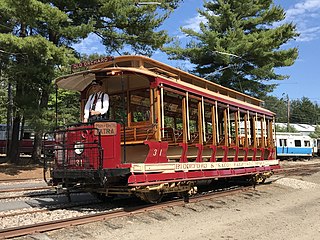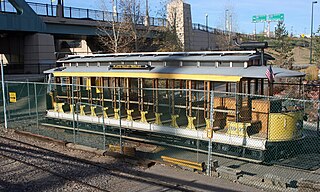
A heritage railway or heritage railroad is a railway operated as living history to re-create or preserve railway scenes of the past. Heritage railways are often old railway lines preserved in a state depicting a period in the history of rail transport.

The San Diego Electric Railway (SDERy) was a mass transit system in Southern California, United States, using 600 volt DC streetcars and buses.

Seashore Trolley Museum, located in Kennebunkport, Maine, United States, is the world's first and largest museum of mass transit vehicles. While the main focus of the collection is trolley cars (trams), it also includes rapid transit trains, Interurban cars, trolley buses, and motor buses. The Seashore Trolley Museum is owned and operated by the New England Electric Railway Historical Society (NEERHS). Of the museum's collection of more than 350 vehicles, ten trolley, and railroad cars that historically operated in Maine were listed on the National Register of Historic Places in 1980, as Maine Trolley Cars.

The Connecticut Trolley Museum, founded in October 1940, is the oldest incorporated museum dedicated to electric railroading in the United States. The museum is located in East Windsor, Connecticut and is open to the public April through December. The museum features static and moving displays, and self-guided tours of the state's trolley history.

Old Pueblo Trolley is a non-profit, educational corporation based in Tucson, in the U.S. state of Arizona, that is dedicated to the preservation of Arizona's mass transit history. The name also commonly refers to the heritage streetcar line which OPT began operating in 1993, on which service is currently indefinitely suspended. OPT consists of three divisions that each fill a specific role in preserving the state's mass transit history. The divisions are the Street Railway Division, Motor Bus Division and the Museum Division.

The Illinois Railway Museum is the largest railroad museum in the United States. It is located in the Chicago metropolitan area at 7000 Olson Road in Union, Illinois, 55 miles (89 km) northwest of downtown Chicago.

Streetcars in Washington, D.C. transported people across the city and region from 1862 until 1962.

The Fort Collins Municipal Railway operated streetcars in Fort Collins, Colorado, from 1919 until 1951. Since 1984, a section of one of the former routes has been in operation as a seasonal heritage streetcar service, under the same name, running primarily on Spring and Summer weekends. The heritage service is operated by volunteers from the Fort Collins Municipal Railway Society (FCMRS). The streetcar in use on the heritage line, Birney "Safety" Streetcar No. 21, is listed on the National Register of Historic Places.

The McKinney Avenue Transit Authority (MATA), a non-profit organization, operates the M-line Trolley in Dallas, Texas (USA). The offices and car barn are located at 3153 Oak Grove, Dallas, TX 75204. In operation since 1989, it is an example of a heritage streetcar running historic cars. The main stretch of the line runs down McKinney Avenue in Uptown. While the "M-Line" name was officially adopted for the service in 2002, the line continues to be commonly known as "the McKinney Avenue trolley".

The Yakima Valley Transportation Company was an interurban electric railroad headquartered in Yakima, Washington. It was operator of the city's streetcar system from 1907–1947, and it also provided the local bus service from the 1920s until 1957.

The Baltimore Streetcar Museum (BSM) is a 501(c)(3) nonprofit museum. It is located at 1911 Falls Road in Baltimore, Maryland. The museum is dedicated to preserving Baltimore's public transportation history, especially the streetcar era.

The Denver Trolley, formerly known as the Platte Valley Trolley, is a heritage streetcar line in Denver, Colorado, operated by the Denver Tramway Heritage Society. It began service on July 4, 1989.

The Pennsylvania Trolley Museum is a museum in Washington, Pennsylvania, dedicated to operation and preservation of streetcars and trolleys. The museum primarily contains historic trolleys from Pennsylvania, but their collection includes examples from nearby Toledo, Ohio; New Orleans, and even an open sided car from Brazil. Many have been painstakingly restored to operating condition. Other unique cars either waiting for restoration or incompatible with the Pennsylvania trolley gauge track are on display in a massive trolley display building. Notable examples on static display include a J.G. Brill “brilliner” car which was introduced as a competitor to the PCC, locomotives, and a horse car from the early days of Pittsburgh’s public transit systems.

The National Capital Trolley Museum (NCTM) is a 501(c)(3) nonprofit organization that operates historic street cars, trolleys and trams for the public on a regular schedule. Located in Montgomery County, Maryland, the museum's primary mission is to preserve and interpret the history of the electric street and interurban railways of the National Capital region.

The Midwest Old Threshers Reunion is an annual event that takes place in the small town of Mt. Pleasant, Iowa, United States, and runs for five days, ending on the Labor Day weekend. It was first held in 1950, and has taken place every year except 2020, when it was cancelled due to the COVID-19 pandemic. When it first started, it focused on steam engines and antique agricultural equipment, but has developed into an entertainment event with a wider remit. The tiny town of less than 10,000 inhabitants receives thousands of visitors from around the world.

The Jewett Car Company was an early 20th-century American industrial company that manufactured streetcars and interurban cars.

The New York Museum of Transportation (NYMT), founded in 1975, is a non-profit organization located at 6393 East River Road, in the Rochester suburb of Rush. A private rail line built by volunteers connects NYMT with the Rochester & Genesee Valley Railroad Museum, over a distance of two miles. This demonstration railway allows both museums to offer train rides with their collections of vintage railroad equipment. NYMT operates the only electric trolley ride in New York State, not to be confused with the similarly named Trolley Museum of New York located in Kingston, New York.

Streetcars in St. Louis, Missouri operated as part of the transportation network of St. Louis from the middle of the 19th century through the early 1960s. During the first forty years of the streetcar in the city, a variety of private companies operated several dozen lines; from the start of the 20th century, most of these companies consolidated into the St. Louis Public Service Company, which served both the city of St. Louis and neighboring St. Louis County, Missouri. Other private companies, such as those serving the Metro East region or St. Charles, Missouri, continued separate operations. Starting in the 1930s and continuing through the 1960s, St. Louis Public Service ended all streetcar service, while other regional operators also ended their services.

The Astoria Riverfront Trolley is a 3-mile (4.8 km) heritage streetcar line that operates in Astoria, Oregon, United States, using former freight railroad tracks along or near the south bank of the Columbia River, with no overhead line. The service began operating in 1999, using a 1913-built streetcar from San Antonio, Texas. As of 2012, the service was reported as carrying 35,000 to 40,000 passengers per year and has been called a "symbol" and "icon" of Astoria. The line's operation is seasonal, normally during spring break and from May through September.




















